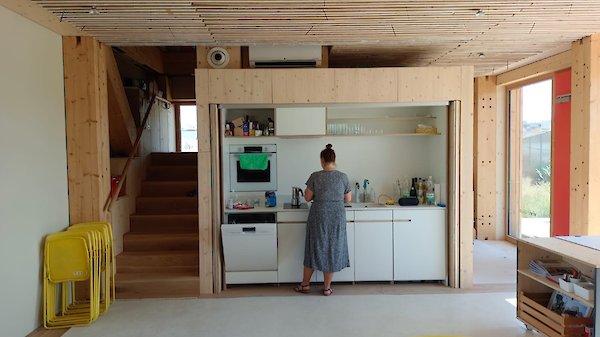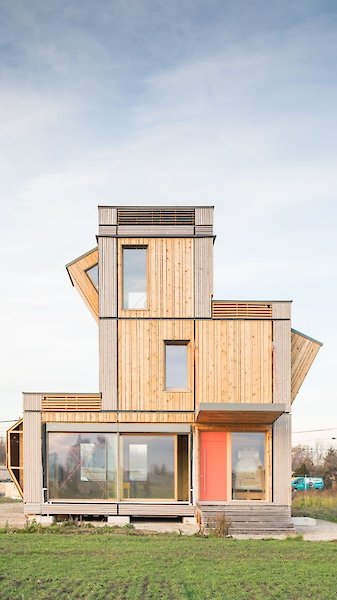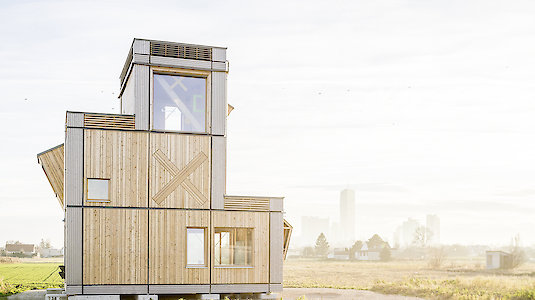The vivihouse: A building philosophy put into practice!
What is "circular economy building"? For example, the Austrian vivihouse project! This is characterised by a modular timber frame construction system. Only renewable raw materials are used for multi-storey buildings.
vivihouse: These are three young architects in Austria and a common visionary idea: Adrian Schulz, Nikolas Kichler and Michael Fürst not only agree that when it comes to building, "you simply can't go on doing things the way they have been" but have also looked into the thoughts of the philosopher Ivan Illich. We talked about this with Michael Fürst.
How did the name "vivihouse" come about? "vivihouse" is a combination of "house" and the adjective "convivial". "Convivial" means "suitable for good living". "Conviviality" denotes a communal behaviour, a togetherness, a communality. These are terms coined in 1973 by the Austrian-US philosopher Ivan Illich (Vienna 1926 - 2002 Bremen).
Tools for conviviality (1973). In his book "Tools for conviviality", he criticised the thoughtless use of tools and pleaded for technologies to be appropriated in such a way that they serve life instead of burdening it. He was reacting to economic developments that led not to human development but to "modernised poverty" and systematic dependence.
Call to self-doing. In this way, people would be reduced more and more to "worn-out mechanical parts". Illich therefore pleaded for "giving people themselves back the tools that guarantee their right to work with independent efficiency". Freely after Ivan Illich: If it becomes possible for everyone to construct multi-storey buildings from renewable raw materials in a self-determined, creative and needs-oriented way, then we can call that "convivial" - in another word: vivihouse! These are our initial thoughts!
Who developed the idea of vivihouse? The three architects Paul Adrian Schulz, Nikolas Kichler and myself under Prof. Karin Stieldorf were in charge, at that time as CEC, Vienna University of Technology in a Climate and Energy Fund funded Smart City R&D project under consultation of: Woschitz Group (supporting structure, wooden high-rise building Seestadt Aspern), Lukas Lang Building Technologies (reversible engineering, temporary parliament), TB Käferhaus (building services), ASBN (instructor for the lay workshops in prefabrication). https://www.iba-wien.at/projekte/projekt-detail/project/vivihouse
How do you explain the concept of vivihouse to interested parties? vivihouse was developed to disseminate sustainable architecture that is fit for the future, also in urban spaces, and to bring about a change in the building sector by opening up building practice to new actors.

The vivihouse construction method makes it possible to build up to six-storey office and residential buildings with ecological building materials. Renewable raw materials, recyclability and energy efficiency are the most important ecological and social aspects in addition to inclusive participation opportunities, affordability and high flexibility and durability. Their combination should contribute to making the design of material cycles in the building sector possible for more and more people and to establishing an effective transformation tool in times of climate change. This video conveys our concerns in an excellent way:https://www.youtube.com/watch?v=6Dd2zY5xeCo
Where has vivihouse already been realised? As part of the R&D project, a three-storey demo house was built in the Donaufeld urban development area, Nordmanngasse 88, 1210 Vienna. It is currently rented by the "Urban Renewal" area management as a communication house. After a few years it will have to be dismantled.
vivihouse can be described as a contemporary, ecological prefabricated house? Yes, but only in a certain sense. Because the term "prefabricated" is too reminiscent of single-family houses. However, our construction system was designed for six-storey office and residential buildings. It is a timber frame construction with prefabricated ceiling and exterior wall elements as well as ready-made wet room modules. Depending on the location, different building services solutions can be integrated. vivihouse is therefore a prefabricated town house.
Is there already data on the ecological impact of vivihouse? Yes, there is. We have made calculations for a four-storey office building and have calculated the passive house standard: approx. 15kWh/m² for the heating demand and approx. 50kWh/m² for the final energy demand. This is an excellent value, but nothing special nowadays.

More interesting are the results for CO2 emissions and grey energy for building construction and disposal. The structural concept was optimised for recyclability, especially for the large volumes - i.e. ceilings, columns and building envelope. The entire building envelope is made of wood and insulated with straw. Instead of solid wood solutions, frame elements and beam ceilings were used. This saves a lot of material, but has the disadvantage of greater construction heights in the ceilings. All prefabricated parts can be dismantled non-destructively
Is there already data on the ecological impact of vivihouse? Yes, there is. We have made calculations for a four-storey office building and have calculated the passive house standard: approx. 15kWh/m² for the heating demand and approx. 50kWh/m² for the final energy demand. This is an excellent value, but nothing special nowadays.
More interesting are the results for CO2 emissions and grey energy for building construction and disposal. The structural concept was optimised for recyclability, especially for the large volumes - i.e. ceilings, columns and building envelope. The entire building envelope is made of wood and insulated with straw. Instead of solid wood solutions, frame elements and beam ceilings were used. This saves a lot of material, but has the disadvantage of greater construction heights in the ceilings. All prefabricated elements can be dismantled non-destructively and reinstalled elsewhere at any time. The entire production process has a negative CO2 balance. This includes transport routes and construction site activities. In the OI3 index we have so far only entered the small-volume prototype. Results: OI3,BG3 indicator 357, disposal indicator EI10: 7.9. For larger buildings, the OI3 indicator should become even smaller.
The vivihouse modules are produced where by whom? So far, we have produced them ourselves in guided lay workshops. This was advantageous for us in several respects during the development process. Now we are in the process of pooling production partners. Ideally, there should be many decentralised producers who can then produce locally instead of one big exclusive one.
We thank Michael Fürst for his clever answers as well as the whole team of vivihouse for their extraordinary commitment to a new, circular economy building including the important building-philosophical approach!
Without the following sponsors, the realisation of vivihouse would not have been possible: Climate and Energy Fund, as well as R&D Lead: TU Vienna CONTINUING EDUCATION CENTER, as well as the main sponsors Wiehag and Katzbeck.
Information: This folder informs very well about what vivihouse is all about:
